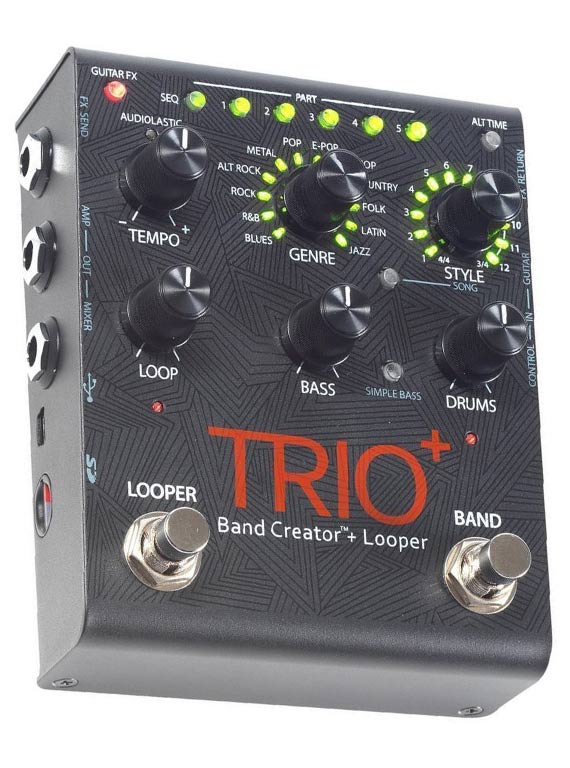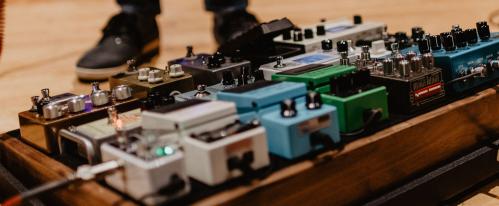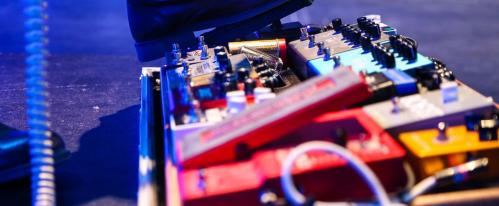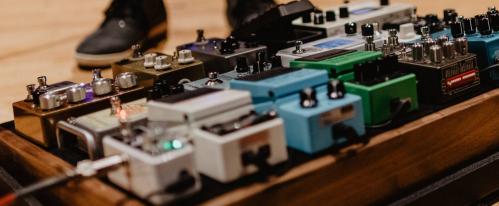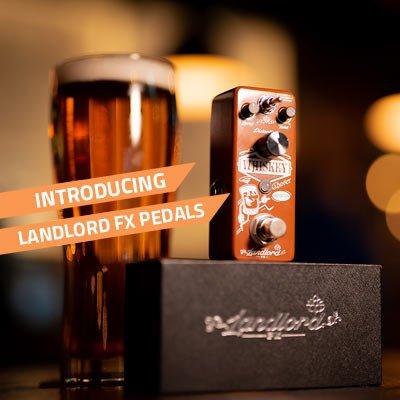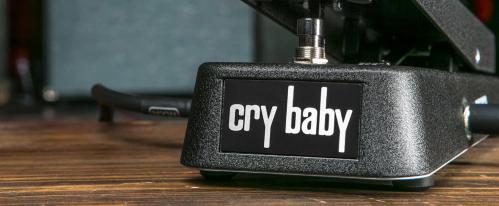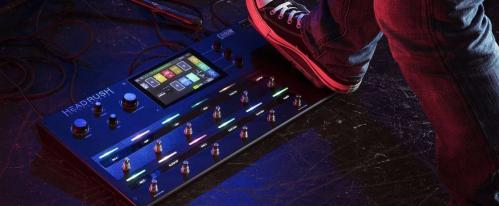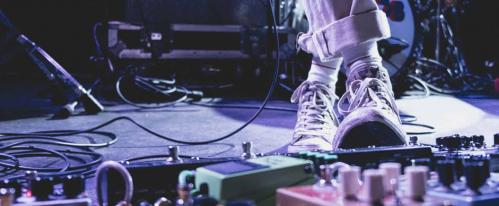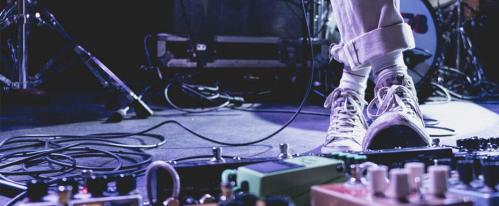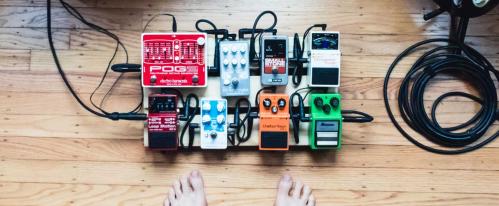THE DIGITECH TRIO WON "BEST IN SHOW" AT NAMM 2015, AND IT'S EASY TO SEE WHY: GUITARISTS THE WORLD OVER GOT INSTANTLY EXCITED BY THIS UNIQUE GUITAR PEDAL! HERE'S EVERYTHING YOU NEED TO KNOW ABOUT THE TRIO BAND CREATOR, AND THE NEW TRIO+, WHICH IS EVEN BETTER!
The DigiTech TRIO Band Creator caused a sensation as soon as it was released: an innovative pedal that learns what you play and adds drum and bass parts automatically, to match your song. Here's what you need to know about the Trio and, further down our blog, we'll talk about the new Trio+ and how both compare. Despite the fact that there are some great demo videos of the DigiTech TRIO pedal circulating at the moment, it's still not clear to some people what it's all about and how exactly it works.
Here's what we think is all the info you need to know, featuring questions which have been in the minds of lots of players recently...
Simple - you play a chord progression, and the TRIO comes up with a drum beat and bass line that fit with it. The optional FS3X footswitch is highly recommended, as it allows you to step through the three different parts in a more fluid way. The FS3X also allows you to change the variations within the genre that you're using, besides the ability to change from part 1 to part 2 and part 3.
No! The TRIO does indeed add drum beats, but it's far from one. Paradoxically, it's simpler and more complex than a drum-machine.
Unlike a drum-machine, you can't program beats. But on the other hand, the TRIO can automatically learn based on what you're playing, and come up with a beat that suits it, thanks to it "adaptive technology". A drum-machine doesn't "learn" or "listen" to what you play: if you buy a drum-machine, you either have to learn how to program it, or fit what you're playing to one of the preset beats. For these reasons, many guitarists may not enjoy playing with a drum-machine.
Drum-machines are great - but better suited for the technically-minded musician who enjoys creating beats. This description doesn't fit many guitarists, and the DigiTech TRIO is the perfect solution: it feels more real, more "organic"... almost like playing with actual musicians! It learns the key, the chords, the tempo and the timing of your chord progression, as you play it along! Unlike a drum-machine, the TRIO won't necessarily play the same thing every time... the beats and bass lines the TRIO will come up with will vary according to what you play, and the rhythm you play... all you need to do is to "tell" it what style you want, such as blues, jazz, pop, rock, etc.
Because you don't have to program anything, the TRIO frees you up to do what you do best - simply play guitar!
IS IT A LOOPER?
No, it doesn't do any recording. However, the new Trio+ is indeed a looper!
The answer is... no! It can simply remember how to accompany the last chord progression you made. Because the pedal has three selectable PART buttons, it means it can remember the accompaniment for up to three different progressions. This could be three different parts for the same song (verse, chorus, bridge) or, for instance, three different beats in the completely different styles (one blues, one pop, one rock).
The TRIO pedal can be unplugged and recall those three last rhythm parts, but in a way, this is besides the point - the TRIO doesn't have a "save" function because it doesn't need to! Like we said before, it's almost like playing alongside real musicians, because it'll just learn as you play along anyway!
It's really designed to be as fuss-free as you can imagine: your job is to play guitar, and let the TRIO do the rest!
This could be a problem... but it isn't! The TRIO offers a whole lot of variation: Seven musical genres to choose from, each of them with 12 style variations. It's simply quite unlikely you wouldn't find a TRIO pattern that wouldn't suit your needs. If you're looking for a space-funk-jazz-punk syncopated beat, then maybe...
The DigiTech TRIO was designed from the ground up to create the illusion of playing with an actual rhythm section – a feeling that is very different than playing to static backing tracks like those offered by a drum-machine.
The styles will follow your own chord progression and transition between chords using an understanding of musical theory. The choice of bass notes is dynamic and will vary both within a part, as well as each time through the part. Furthermore, the TRIO styles were created using recordings from some of Nashville's top session players. The drums for each style have two sections, roughly corresponding to verse and chorus.
The verse sections are used on Part 1 of the TRIO, and the chorus sections are used in Part 2 and 3. Various drum voicing substitutions are used to give some variety within a part and between parts.
For instance, if you choose a drum pattern in the "Rock" genre, you can then select one of these styles:
1) Classic rock. Sounds best at tempos between 60-110. Bass similar to rock style #2 but slightly more spacious. Classic rock drums, with hats changing to cymbals and busier kick in chorus.
2) Driving British rock. Sounds best at tempos between 80-130. Bass sitting on root, with occasional 5th or octave jump. Hard rock drums with hats changing to cymbals in chorus.
3) Easy listening rock. Sounds best at tempos between 110-160. Simple bass rhythm locked on root of chord. Standard rock drums with hats changing to cymbals in chorus.
4) Uplifting rock. Sounds best at tempos between 100-150. Driving bass on 16th notes. Driving rock beat with 4/4 kick and grooving high-hat in verse and more intense snare in chorus.
5) Funky blues rock. Sounds best at tempos between 110-150. Driving 16ths bass line with no complex transitions. Drums have a driving rock beat with percussion, toms and more cowbell featured in chorus.
6) Northern rock. Sounds best at tempos between 65-110. Bass sounding octaves with short walking transitions between chords. Big rock drums with loose open hat and snare in verse going to cymbal and snare in chorus.
7) British invasion. Sounds best at tempos between 100-140. Slightly bluesy bass with lots of motion in transition bars. Straight rock beat with steady snare and tight 16th note hats in verse changing to 8th note cymbals in chorus.
8) Swung British rock. Sounds best at tempos between 65-110. Slightly bluesy bass sits on root and walks up chord in 2nd half of bar. Swung UK rock and roll beat with hats in verse changing to cymbals in the chorus.
9) Southern rock. Sounds best at tempos between 80-120. Southern boogie bass with bluesy transitions between chords. Swung rock and roll beat with restrained hats in verse and even ride in the chorus.
10) R&B rock in 3/4. Sounds best at tempos between 80-120. Simple bass on the root of the chord. Drums switch from simple kick and snare with grooving hats in the verse to ride in the chorus.
11) Country rock in 3/4. Sounds best at tempos between 80-135. Bass consists mainly of even notes on root with walking passages between chords. Rock waltz with hats and double kick pattern in verse and ride cymbals and more relaxed kick in the chorus.
12) Swung northern waltz. Sounds best at tempos between 70-120. Grooving bass alternates between root and 2nd below with short walks between chords. Cymbal heavy, British rock drum feel. And if this doesn't sound impressive enough, here's something amazing about the TRIO: The first time you teach the TRIO a progression it will automatically choose the best style for your chord progression based on the genre that is selected, so you don't even need to think about it! It doesn't matter which genre you use when teaching the TRIO a song.
You can always switch between genres and styles at any time to hear a different groove or feel based on your original song idea. And if you want, you can also speed up or slow down the rhythm track using the TEMPO knob - without changing the pitch!
Using a DigiTech TRIO is more than just a bit like playing with real musicians: you tell them "Let's play a rock song" or "Let's play some blues" and leave them to it! But then, maybe you can say "Let's speed it up a bit" or "let's change the feel a little bit".
Yes! The TRIO is perfect for solo singer-songwriters and even Open Mic performers! However, bear in mind your acoustic guitar MUST have a pickup - the TRIO will only generate a beat if there's a guitar sound coming through it.
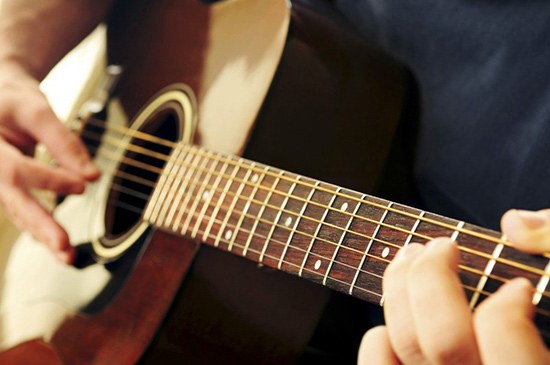
CAN TRIO PLAY JUST DRUMS, OR JUST BASS?
Yes! Although it creates bass and drum parts simultaneously, both bass and drums have separate volume control levels, so you can turn down either completely if you so wish, besides being able to mix their level according to your tastes.
DOES IT HAVE BUILT-IN FX?
Yes! However, this is not a "multi-effects" pedal, it's simply not about that! It does have a Speaker Cab Simulation FX when guitar output is coming through MIXER OUT or HEADPHONES OUT.
When using the main GUITAR output, you can click on Guitar FX button to select: LED Off - The guitar effects are not enabled. LED Green - Indicates that a rhythm guitar effect will be used for the 'Learning' and 'Playing' states. LED Red - Indicates that a rhythm guitar effect will be used for the 'Learning' state and a lead guitar effect for the 'Playing' state. The type of effects added are dependent on the genre selected. You can't control the parameters.
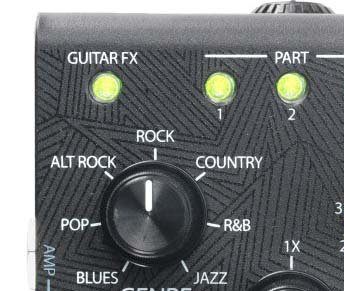
DOES IT HAVE MIDI SYNC?
No, it wasn't made to sync with other units.
DOES IT HAVE USB PORT?
Yes, but it's not used at the moment. It'll be used for future updates, perhaps new samples, or correct eventual bugs and maybe even improved learning algorithms. This means that your new TRIO pedal will still remain current and usable in the future!
WHAT'S THE BEST WAY TO PLUG MY DIGITECH TRIO PEDAL?
There are four different ways you can connect your Trio pedal. You should always play your guitar clean when TRIO is engaged in "Learn" mode.
1) To Guitar Amp only If you only have a guitar amp, that's ok. When you only use the GUITAR output, TRIO will optimize the Drum/Bass sound to take into account the fact it's going to a guitar amp. However, it's advised you use a clean guitar amp sound, so it won't distort the rhythm part.
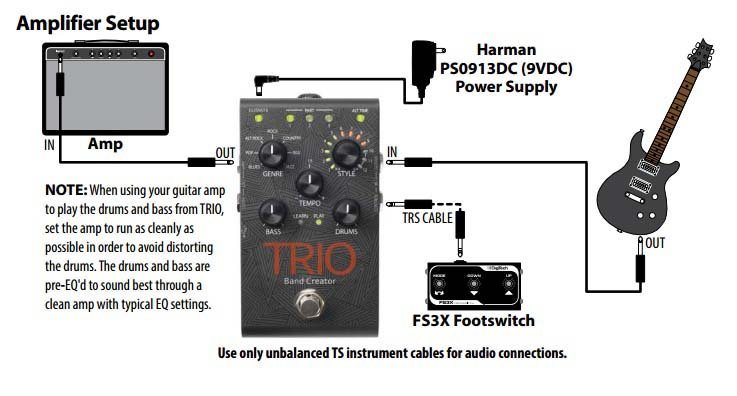
2) To PA Mixer Only When plugging to the PA only, choose MIXER output. This will give you the best possible sound, and your guitar will automatically be treated with a speaker cabinet simulation effect, for a better, more natural sound.
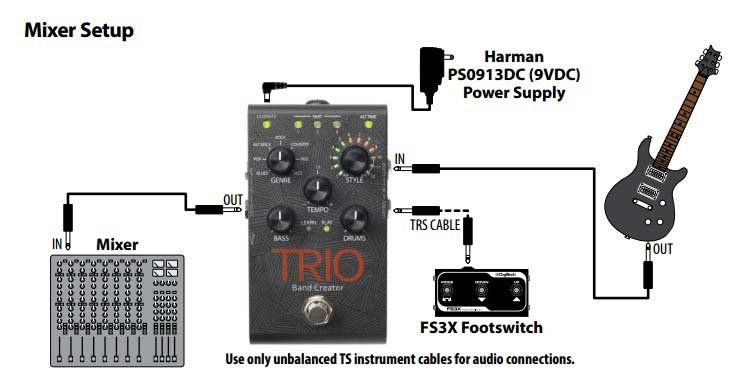
3) To Guitar and Mixer Simultaneously This is by far the best way to use TRIO, because when both GUITAR and MIXER outputs are being used, TRIO will automatically separate the guitar and rhythm part signals! Your guitar sound will go to your guitar amp, while the bass and drums will go to mixer, allowing for better EQ. You can also use this setup if you own a guitar amp with separate inputs or AUX IN.
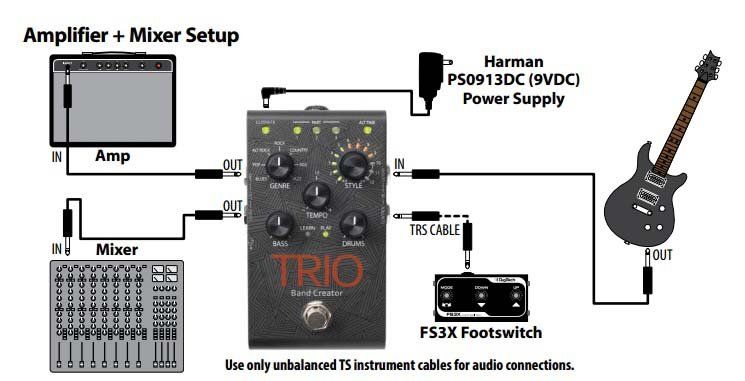
4) To Headphones TRIO is ideal for silent practice at home! It features a headphones output with volume control, and instantly adds speaker cabinet simulation to your guitar sound.
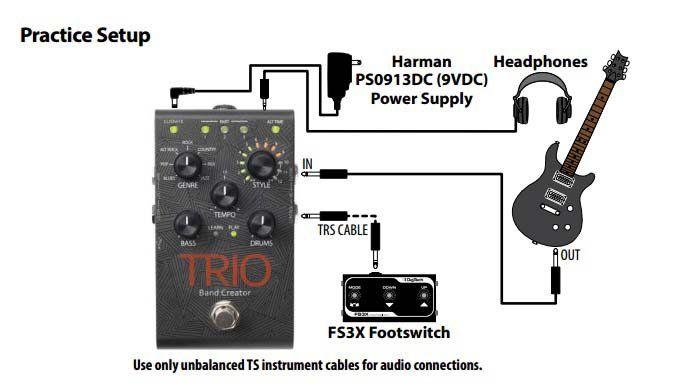
HOW DO I PLACE TRIO ON MY PEDALBOARD?
This could potentially be tricky, so you should be mindful on how you use it. In order to best learn the songs, TRIO needs a clean signal, so the best option would be for it to go first in your chain, or after the tuner... but only if you're using option 3 described above! In this situation, your guitar signal will go from trio to your other pedals, and drum & bass parts will go straight to mixer, unaffected.
This setup would also allow you to have an effected sound with delays, distortions etc while TRIO engaged in LEARN mode, as the sound going to TRIO itself would still be clean! Alternatively, you're better advised to get the new TRIO+, because it has an FX Loop, which makes everything so much easier!
WHAT ARE THE BEST SITUATIONS TO USE A TRIO PEDAL?
There are several reasons why you could use a TRIO, here's some possible scenarios:
- As a songwriter testing out how song would sound with drums and / or bass
- As a novice player, to experience how it's like to play with a backing band
- Your band lost / can't find a bassist or drummer, use TRIO as your stand by, temporary "band member"
- Use TRIO as a backing band if you're a solo performer, to beef up your sound.
- Use TRIO just to have more fun when practising on your own at home, as it's got a more realistic feel than a drum-machine!
DOES TRIO WORKS ON BATTERIES? Unfortunately, no. This pedal requires a 9V power supply, included.
SHOULD I GET THE DIGITECH TRIO+ OR THE ORIGINAL TRIO?
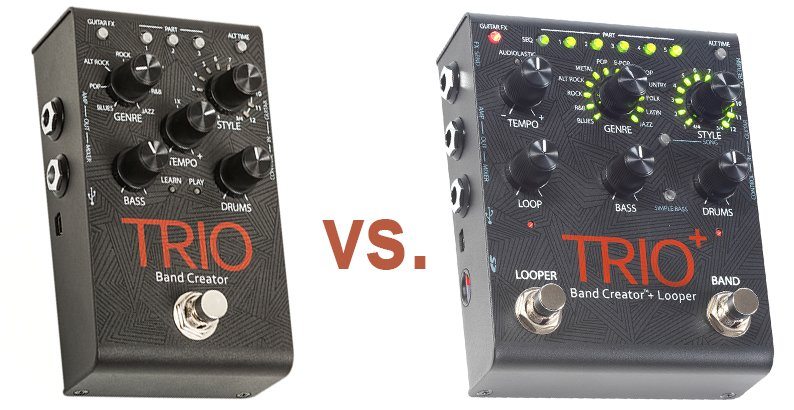
Is it time to get rid of your old Trio and buy a Trio+? Or, if you don't own one yet, should you buy the new model or stick to the (cheaper) original Trio? As usual in this cases, the answer will vary according to each player needs:
- If you already own a Trio and you're looking for a looper pedal, you could consider selling your old Trio and buying a Trio+, if your pedalboard is short of space! But if you think you don't need the new features, and you have space on your board, you might be happy just buying a looper pedal.
- If you're just looking for a looper pedal, you could consider first buying a Trio+! Think of it this way: you can use Trio+ like any other looper pedal, with infinite overdubs and a looping time that's as long as you're likely to ever need. But it could be cool to pay that little extra to also have the "Band Creator" feature, which no other looper does... so you can practice at home etc with your new pedal!
- If you're thinking about getting a Trio pedal, then you should consider the Trio+, simply because it's got more features: FX loop, more musical styles, etc! But, of course, if you don't think you need the extra features and are not bothered about having a looper, then the original Trio is the way to go.
WHAT ARE THE DIFFERENCES BETWEEN DIGITECH TRIO+ AND THE ORIGINAL TRIO?
In summary, besides the added looper feature, the new Trio+ offers improvements on the previous Trio:
- 12 musical genres on Trio +, instead of just 7 on Trio.
- New genres include hip-hop, E-pop, Folk, Country and Latin
- Trio+ learns up to 5 different song parts, instead of just 3 on Trio
- Trio+ features new "Simple Bass" button that creates simpler basslines
- Trio+ also features SD card Expansion
- Trio+ has FX Send/ Return Loop
Shop a full range of Digitech effects pedals over at PMT online today or call in to your local store to speak to our experts.

